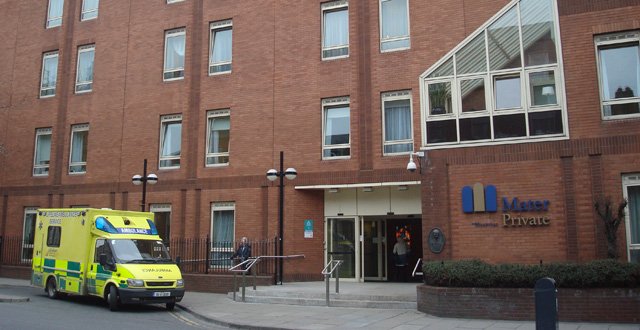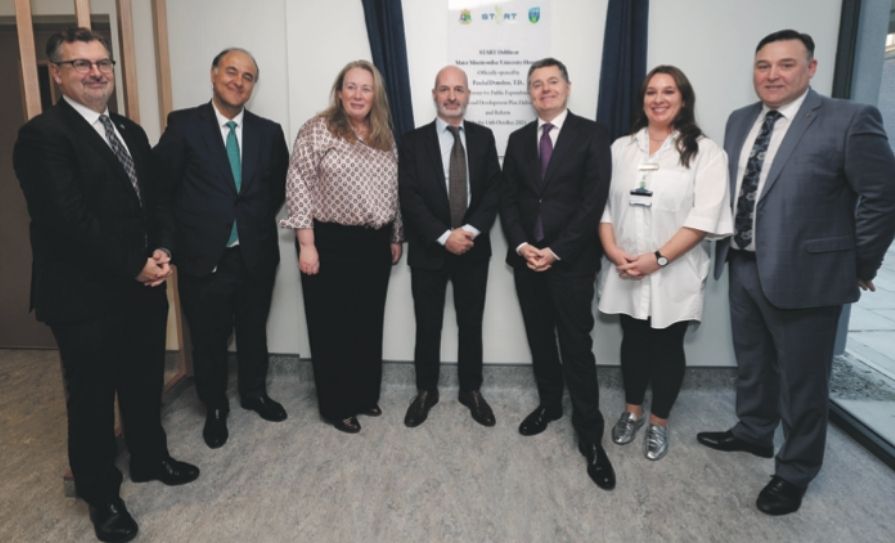The Mater Misericordiae University Hospital, Dublin, has opened a centre for point-of-care ultrasound education
Have you ever stood at the bed of a critically-shocked patient, wondering if they have cardiac tamponade and was not sure if the heart sounds were ‘muffled’?
Been uncertain if your dyspnoeic patient has heart failure or infection? Not 100 per cent sure whether the crepitations were fine or coarse and the chest x-ray didn’t help that much?
Repeatedly tried unsuccessfully to get IV access and wondered if there is a better way for you and your patient?
If the answer is ‘yes’ and you find that your stethoscope doesn’t always give you these answers, it is time you learned about point-of-care ultrasound (POCUS) and what we are doing at the Mater Hospital to educate more medical professionals about this exciting and innovative technology.
What is POCUS?
POCUS is ‘seeing with sound’ — the clinician managing the patient is actively acquiring, interpreting and clinically integrating focused ultrasound in real time to help guide management decisions at the patient’s bedside. You may also have heard it referred to as ‘bedside ultrasound’, ‘clinician-performed ultrasound’ or ‘emergency ultrasound’.
It is different from comprehensive diagnostic sonography, such as radiology ultrasound, echocardiography, and early pregnancy scanning. POCUS asks a binary question and generates a focused answer that the treating clinician must integrate into the clinical care of their patient. POCUS has the potential to expedite care and diagnosis, as well as improve patient safety. Technology has reached the point where ultra-portable hand-held ultrasound systems could replace the stethoscope for this generation in medicine.
Why should you learn POCUS?
POCUS allows you to provide better care to your patients. It allows you to diagnose your sickest patients faster. POCUS allows you to make life-saving interventions based on information obtained at the bedside to answer clinical questions such as, ‘does my patient have cardiac tamponade, massive pulmonary emboli, pleural effusion, pneumothorax or pulmonary oedema?’
POCUS is established as the international standard of care for the insertion of central venous catheters. It has been demonstrated to enhance the safety and efficacy of diagnostic and therapeutic procedures such as thoracentesis, pleurocentesis, paracentesis, arthrocentesis, nerve blocks and lumbar puncture. By using real-time, image-guided techniques, it is possible to reduce pain and complication rates for these procedures.
POCUS in mainstream medical education and practice
POCUS is vertically integrated (starting in year-one anatomy) in undergraduate medical curricula in progressive medical schools across North America. It has been suggested that the traditional four pillars of clinical examination— inspection, palpation, percussion and auscultation — should be extended to add a fifth pillar: Insonation.
POCUS is established as an integral part of patient care in specialties such as emergency and critical care medicine, and increasingly so in other specialties such as internal and respiratory medicine, sports and exercise medicine, rheumatology and nephrology. POCUS has transformed the practice of emergency medicine (EM) in America and it has become part of routine clinical assessment of patients in the emergency department (ED).
POCUS has been embedded in EM residency training in the US for 15 years — competency and sign-off is necessary for progression to attending (consultant) status. Though not obligatory in the Australian system currently, modular training pathways are well established. In Germany, Focused Assessment with Sonography in Trauma (FAST) scanning was first described almost 50 years ago and many specialists, such as vascular physicians and gastroenterologists, use POCUS in their routine assessment of patients. In France, lung ultrasound was first described by Daniel Lichtenstein almost 30 years ago, and when combined with clinical assessment has been shown to be more accurate than CXR for diagnosis of acute pulmonary oedema. The role of POCUS in cardiac arrest has been recognised and is taught in Focused Echo in Emergency Life support (FEEL) courses run by the UK Resuscitation Council.
The Royal College of Physicians in the UK has partnered with the Society of Acute Medicine to teach their trainees ‘Ultrasound at the Front Door’. This is an introductory course for general internal medicine (GIM) trainees and includes training on POCUS modules in thoracic, abdominal, renal, DVT, focused ECHO and peripheral venous access. The RCPI is currently planning its inaugural workshop for Irish GIM trainees.
Clinical cases – using POCUS in practice
Case report 1
“Something’s just not right, doctor”
A 50-year old male self-referred to a busy urban medical assessment unit. He described that he had been experiencing dyspnoea at rest and that his heart rate tracking watch had been reading unusually high values over a five-day period
Clinical examination showed a sinus tachycardia and unilateral reduced breath sounds.
POCUS-augmented examination showed a massive pericardial effusion with near compression of the right ventricle during diastole. Lung ultrasound discovered bilateral lung effusions.
Cardiac tamponade physiologic changes were felt to be imminent and the patient was transferred to the cardiac interventional suite for urgent drainage. Emeregency pericardiocentesis found 700ml of blood-stained pericardial fluid and cardiac homeostasis was restored.
This patient was admitted for investigation of the underlying cause once stabilised. Without doubt, early diagnosis and intervention in this case prevented further deterioration.
Case report 2
“There’s something in my foot!”
A 60-year-old female patient presented with a soft tissue foreign body in the sole of her foot. The limb had become increasingly painful and swollen. She had not tolerated previous local anaesthetic instillation and presented to our unit in pain and limping.
Soft tissue ultrasound showed a 20mm foreign object in the mid foot localised at a depth of 10mm. Using ultrasound-guided posterior tibial nerve block, her foot was anaesthetised and the glass fragment was retrieved. The procedure was well tolerated by the patient and she was discharged to primary care.
In this case, acute surgical admission to hospital was unnecessary since ultrasound was used wisely in the ED and facilitated early and safe discharge.
All the clinical ultrasound images were recorded with a hand-held ButterflyIQ ultrasound device (www.butterflynetwork.com).
POCUS at the PILLAR
We believe that POCUS is the most exciting development in clinical medicine in our generation and will be pivotal in the paradigm shift from the use of 19th Century technology to that of the 21st Century for bedside clinical diagnosis of human disease.
We have established a centre for POCUS education in the Pillar Centre for Transformative Healthcare in the Mater Hospital.
POCUS at the PILLAR will provide POCUS training targeted at, but not limited to, clinicians working in EM, critical care medicine, cardiology, acute medicine, GIM, and respiratory medicine. Check out our website, www.sono247.org.
Training options will be flexible according to the learners’ availability, location and training needs. As such, we can compile a bespoke educational package to suit individual needs.
The following training options are available:
Introductory courses with pre-course online learning modules allowing for 75 per cent of the day to involve ‘probe-in-hand’ learning with both normal and abnormal pathology findings.
Six-month heart and lung point-of-care ultrasound modules for clinicians caring for acutely ill medical patients.
Internships where learners spend from two-to-six weeks in hospital immersed in a full range of POCUS and procedures with supervised scan review and a quality assurance process.
Credentialling and accreditation will be available on completion of each training module.
The RCPI in conjunction with POCUS at the PILLAR delivered a one-day introduction to ultrasound-guided procedures workshop for Irish GIM trainees in the Mater Hospital on 15 November 2019. This was a high-energy and hands-on course that was well received by the training body and participants.
The faculty commented: “It was fantastic to facilitate experienced doctors [to] experience a light-bulb moment as they learned new practical skills”.
Feedback from learners was also positive: “I wish that we had been taught POCUS starting in medical school — it is such a useful tool to use for your patient. I can’t wait to go back to our hospital and practice. I highly recommend this course.”
References available on request
The POCUS at the PILLAR introduction to heart and lung ultrasound course took place on 13 December 2019. For more information and details of upcoming POCUS courses, email POCUSpillar@mater.ie. Follow us on twitter @ThePillarDublin
About the POCUS instructors
Dr Cian McDermott, FACEM, FRCEM, CCPU. Co-Director of Emergency Ultrasound education and Consultant in Emergency Medicine, Mater Hospital, Dublin. Dr McDermott trained and credentialled in point-of-care ultrasound in Melbourne, Australia, and he directs and teaches workshops both nationally and internationally. See @cianmcdermott
Dr Tomás Breslin is a Consultant in Emergency Medicine in the Mater Hospital and Associate Clinical Professor in University College Dublin School of Medicine. He is co-founder of the VTE Dublin conference, which hosted its fifth annual ultrasound workshop this month and teaches POCUS to emergency medicine trainees locally and nationally.













Leave a Reply
You must be logged in to post a comment.